Prof. Mercier has been selected as a recipient of the Biocom Life Science Catalyst Awards! The awards are given to accomplished and up-and-coming academics, entrepreneurs, investors, corporate leaders and business advisers who are making their marks on the San Diego and Los Angeles life science communities before reaching their 40th birthdays. Read more HERE.
Stretchable biofuel cells extract energy from sweat to power wearable devices at 1mW/cm^2

A team of engineers has developed stretchable fuel cells that extract energy from sweat and are capable of powering electronics, such as LEDs and Bluetooth radios. The biofuel cells generate 10 times more power per surface area than any existing wearable biofuel cells. The devices could be used to power a range of wearable devices.
The epidermal biofuel cells are a major breakthrough in the field, which has been struggling with making the devices that are stretchable enough and powerful enough. Engineers from the University of California San Diego were able to achieve this breakthrough thanks to a combination of clever chemistry, advanced materials and electronic interfaces. This allowed them to build a stretchable electronic foundation by using lithography and by using screen-printing to make 3D carbon nanotube-based cathode and anode arrays. The developed system generated sufficient power to, for the first time, operate a Bluetooth-enabled wearable sensor, when powered exclusively from the biofuel cell.
Read more about the research HERE, or in the corresponding Energy and Environmental Science paper.
Four papers at ESSCIRC’17, one at BioCAS’17, and one at IEEE Sensors’17
 The Energy-Efficient Microsystems Lab will present four papers at ESSCIRC 2017:
The Energy-Efficient Microsystems Lab will present four papers at ESSCIRC 2017:
- A sub-pW voltage reference generator, to be presented by Hui Wang
- A pW-level relaxation oscillator featuring a very low power current-reference generator, to be presented by Hui Wang
- A 4.5nW 400MHz wake-up receiver with -63.8dBm sensitivity, to be presented by Po-Han Wang (collaboration with Profs. Hall, Rebeiz, and Kim)
- A battery-connected wireless ion sensing system consuming 5.5nW of power, to be presented by Hui Wang (collaboration with Prof. Wang)
The EEMS Lab will also have a paper at BioCAS 2017 on the topic of coil design for mm-sized implantable systems, and at the IEEE Sensors summarizing state-of-the-art in low-power temperature sensors, including a dive into a pW-level temperature sensor recently implemented by the lab.
Low-cost smart glove translates American Sign Language alphabet and controls virtual objects
Engineers at the University of California San Diego have developed a smart glove that wirelessly translates the American Sign Language alphabet into text and controls a virtual hand to mimic sign language gestures. The device, which engineers call “The Language of Glove,” was built for less than $100 using stretchable and printable electronics that are inexpensive, commercially available and easy to assemble. The work was published on July 12 in the journal PLoS ONE.
In addition to decoding American Sign Language gestures, researchers are developing the glove to be used in a variety of other applications ranging from virtual and augmented reality to telesurgery, technical training and defense.
Read more about this project HERE.
Near-zero-power temperature sensor could enable next-generation ‘unawearables’
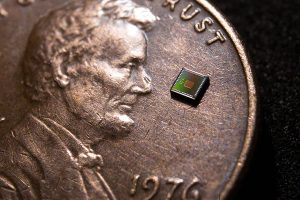 Electrical engineers at the University of California San Diego have developed a temperature sensor that runs on only 113 picowatts of power — 628 times lower power than the state of the art and about 10 billion times smaller than a watt. This “near-zero-power” temperature sensor could extend the battery life of wearable or implantable devices that monitor body temperature, smart home monitoring systems, Internet of Things devices and environmental monitoring systems.
Electrical engineers at the University of California San Diego have developed a temperature sensor that runs on only 113 picowatts of power — 628 times lower power than the state of the art and about 10 billion times smaller than a watt. This “near-zero-power” temperature sensor could extend the battery life of wearable or implantable devices that monitor body temperature, smart home monitoring systems, Internet of Things devices and environmental monitoring systems.
The technology could also enable a new class of devices that can be powered by harvesting energy from low-power sources, such as the body or the surrounding environment, researchers said. The work was published in Scientific Reports on June 30.
“Our vision is to make wearable devices that are so unobtrusive, so invisible that users are virtually unaware that they’re wearing their wearables, making them ‘unawearables.’ Our new near-zero-power technology could one day eliminate the need to ever change or recharge a battery,” said Patrick Mercier, an electrical engineering professor at UC San Diego Jacobs School of Engineering and the study’s senior author.
Read the rest of the press article describing this technology HERE, or view the publication directly on the Nature website.
Prof. Mercier talks tech with Congressional staff in Washington, D.C.
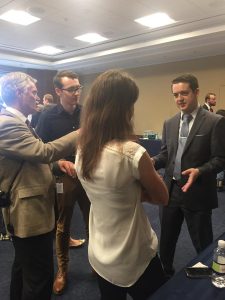 In the wake of the March for Science, scientists and science supporters worldwide are actively seeking ways to connect and engage with their political representatives, in hopes of bridging the gap between science and public policy.
In the wake of the March for Science, scientists and science supporters worldwide are actively seeking ways to connect and engage with their political representatives, in hopes of bridging the gap between science and public policy.
Patrick Mercier, an electrical engineering professor at UC San Diego, got the chance to do just that at an event on Capitol Hill in Washington, D.C. He met with staff members working for representatives for San Diego County and for California Senator Dianne Feinstein. He also showcased research projects conducted under the umbrella of the Center for Wearable Sensors at the Jacobs School of Engineering at UC San Diego.
The event was the BioMedical Technology Exhibition hosted by the American Institute for Medical and Biological Engineering (AIMBE) in partnership with the Congressional Research and Development Caucus and the Congressional Robotics Caucus. Mercier was among a group of researchers to present their cutting-edge technologies to Congressional staff in the U.S. House of Representatives. The event took place on May 5, 2017.
Read more about this here.
Three papers at ISSCC 2017!
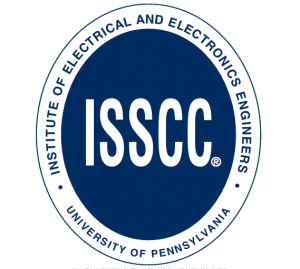 Congratulations to Po-Han Wang, Haowei Jiang, Li Gao, Pinar Sen, and the UCSD N-ZERO team (including Drew Hall, Gabriel Rebiez, and Young-Han Kim) for their upcoming ISSCC paper describing a new ultra-low-power wake-up radio design. The paper is entitled “A 4.5nW Wake-up Radio with -69dBm Sensitivity”.
Congratulations to Po-Han Wang, Haowei Jiang, Li Gao, Pinar Sen, and the UCSD N-ZERO team (including Drew Hall, Gabriel Rebiez, and Young-Han Kim) for their upcoming ISSCC paper describing a new ultra-low-power wake-up radio design. The paper is entitled “A 4.5nW Wake-up Radio with -69dBm Sensitivity”.
Also, congratulations to Loai Salem and Julian Warchall, who have a paper entitled “A 100nA-to-2mA Successive-Approximation Digital LDO with PD Compensation and Sub-LSB Duty Control Achieving a 15.1ns Response Time at 0.5V” accepted for publication. The paper describes a novel digital LDO architecture with significant performance improvements over prior art.
Loai Salem also has a second paper (!) accepted, entitled “A 0.4-to-1V 1MHz-to-2GHz Switched-Capacitor Adiabatic Clock Driver Achieving 55.6% Clock Power Reduction”, describing a new way to efficiently synthesize adiabatic clock waveforms in a very small area.
All papers will be presented at ISSCC 2017 in San Francisco, California. More information on these papers will be available in February at the conference.
Papers in JSSC, TBME, ESSCIRC, and the Proceedings of the IEEE
Congrats to Hui Wang, who had his work on low-power capacitive-discharging oscillators published in the June issue of the IEEE Journal of Solid-State Circuits. The paper, which shows both pW and nW temperature-stabilized oscillators, can be found here.
Further congrats to Jiwoong Park, whose paper modeling capacitive Human Body Communication (HBC) links more accurately, and in more detail than in any prior work, has been published in the IEEE Transactions on Biomedical Engineering. His work showed that using large bench top devices like network analyzers or spectrum analyzers, even when including baluns, does not accurately reflect the performance of capacitive HBC links. The paper, which can be found here, measures such performance using a form-factor-accurate device, and then proposes a new hybrid model to predict the performance of general capacitive HBC links.
The European Solid-State Circuits Conference (ESSCIRC), held this year in Lausanne, Switzerland in September, will feature a paper by Loai Salem which shows a brand new type of power amplifier that can synthesize RF waveforms directly from a lithium ion battery in an efficient way using only ~1V CMOS transistors and no output matching/impedance transformation network. More details regarding this completely new approach will be available at the conference beginning September 12, 2016.
Finally, congrats to the ENIAC team from the Mercier and Cauwenberghs research groups, for publishing a great paper on Silicon Integrated High-Density Electrocortical Interfaces in the Proceedings of the IEEE. The paper nicely summarizes the challenges and opportunities in ECoG-like technologies, while proposing new fully-integrated wireless neural interfacing chips that are fully modular for next-generation brain mapping research. The paper can be found here.
UC San Diego, SDSU to Roll Out Research Platform to Improve Hearing-Aid Technologies
A team of engineers from the University of California San Diego and audiologists from San Diego State University has set out an ambitious timetable for delivering two new electronic platforms to dramatically improve and accelerate research on better hearing aids. Led by Qualcomm Institute research scientist Harinath Garudadri as well as UC San Diego co-principal investigators and Electrical and Computer Engineering (ECE) professors Patrick Mercier and Bhaskar Rao, the UC San Diego-SDSU team has been awarded a $2.1 million grant from the National Institute on Deafness and Communication Disorders (NIDCD), one of the National Institutes of Health (NIH). More information about this program can be found here.
Flexible Wearable Electronic Skin Patch Offers New Way to Monitor Alcohol Levels
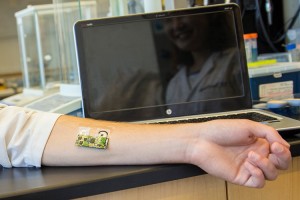
Flexible wearable sensor for detecting alcohol level can be worn on the arm.
Engineers at the University of California San Diego have developed a flexible wearable sensor that can accurately measure a person’s blood alcohol level from sweat and transmit the data wirelessly to a laptop, smartphone or other mobile device. The device can be worn on the skin and could be used by doctors and police officers for continuous, non-invasive and real-time monitoring of blood alcohol content.
The device consists of a temporary tattoo—which sticks to the skin, induces sweat and electrochemically detects the alcohol level—and a portable flexible electronic circuit board, which is connected to the tattoo by a magnet and can communicate the information to a mobile device via Bluetooth. The work, led by nanoengineering professor Joseph Wang and electrical engineering professor Patrick Mercier, both at UC San Diego, was published recently in the journal ACS Sensors.
“Lots of accidents on the road are caused by drunk driving. This technology provides an accurate, convenient and quick way to monitor alcohol consumption to help prevent people from driving while intoxicated,” Wang said. The device could be integrated with a car’s alcohol ignition interlocks, or friends could use it to check up on each other before handing over the car keys, he added.
“When you’re out at a party or at a bar, this sensor could send alerts to your phone to let you know how much you’ve been drinking,” said Jayoung Kim, a materials science and engineering PhD student in Wang’s group and one of the paper’s co-first authors.
Blood alcohol concentration is the most accurate indicator of a person’s alcohol level, but measuring it requires pricking a finger. Breathalyzers, which are the most commonly used devices to indirectly estimate blood alcohol concentration, are non-invasive, but they can give false readouts. For example, the alcohol level detected in a person’s breath right after taking a drink would typically appear higher than that person’s actual blood alcohol concentration. A person could also fool a breathalyzer into detecting a lower alcohol level by using mouthwash.
Recent research has shown that blood alcohol concentration can also be estimated by measuring alcohol levels in what’s called insensible sweat—perspiration that happens before it’s perceived as moisture on the skin. But this measurement can be up to two hours behind the actual blood alcohol reading. On the other hand, the alcohol level in sensible sweat—the sweat that’s typically seen—is a better real-time indicator of the blood alcohol concentration, but so far the systems that can measure this are neither portable nor fit for wearing on the body.
Now, UC San Diego researchers have developed an alcohol sensor that’s wearable, portable and could accurately monitor alcohol level in sweat within 15 minutes.
“What’s also innovative about this technology is that the wearer doesn’t need to be exercising or sweating already. The user can put on the patch and within a few minutes get a reading that’s well correlated to his or her blood alcohol concentration. Such a device hasn’t been available until now,” Mercier said.
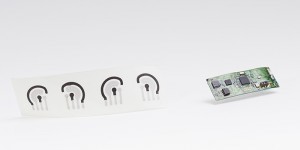 How it works
How it works
Wang and Mercier, the director and co-director, respectively, of the UC San Diego Center for Wearable Sensors, collaborated to develop the device. Wang’s group fabricated the tattoo, equipped with screen-printed electrodes and a small hydrogel patch containing pilocarpine, a drug that passes through the skin and induces sweat.
Mercier’s group developed the printed flexible electronic circuit board that powers the tattoo and can communicate wirelessly with a mobile device. His team also developed the magnetic connector that attaches the electronic circuit board to the tattoo, as well as the device’s phone app.
“This device can use a Bluetooth connection, which is something a breathalyzer can’t do. We’ve found a way to make the electronics portable and wireless, which are important for practical, real-life use,” said Somayeh Imani, an electrical engineering PhD student in Mercier’s lab and a co-first author on the paper.
The tattoo works first by releasing pilocarpine to induce sweat. Then, the sweat comes into contact with an electrode coated with alcohol oxidase, an enzyme that selectively reacts with alcohol to generate hydrogen peroxide, which is electrochemically detected. That information is sent to the electronic circuit board as electrical signals. The data are communicated wirelessly to a mobile device.
Putting the tattoo to the test
Researchers tested the alcohol sensor on 9 healthy volunteers who wore the tattoo on their arms before and after consuming an alcoholic beverage (either a bottle of beer or glass of red wine). The readouts accurately reflected the wearers’ blood alcohol concentrations.
The device also gave accurate readouts even after repeated bending and shaking. This shows that the sensor won’t be affected by the wearer’s movements, researchers said.
As a next step, the team is developing a device that could continuously monitor alcohol levels for 24 hours.
More photos of the device can be found here.
Full paper: “Noninvasive Alcohol Monitoring Using a Wearable Tattoo-Based Iontophoretic-Biosensing System.” Authors of the paper are Jayoung Kim,* Itthipon Jeerapan,* Somayeh Imani,* Thomas N. Cho, Amay Bandodkar, Stefano Cinti, Patrick P. Mercier and Joseph Wang, all from UC San Diego.
*These authors contributed equally to this work.
This work was supported by the National Institute of Biomedical Imaging and Bioengineering of the National Institutes of Health (grant no. R21EB019698), the Defense Threat Reduction Agency Joint Science and Technology Office for Chemical and Biological Defense (grant no. HDTRA1-16-1-0013) and the UC San Diego Center for Wearable Sensors.
UC San Diego Inventions Gain $6-Million Venture-Capital Backing
 “MouthSense” and “SmartFoam,” two new inventions by engineers in the Jacobs School of Engineering at the University of California San Diego, have attracted funding from NextWave Venture Partners, a venture-capital firm specializing in the commercialization of early-stage technologies.
“MouthSense” and “SmartFoam,” two new inventions by engineers in the Jacobs School of Engineering at the University of California San Diego, have attracted funding from NextWave Venture Partners, a venture-capital firm specializing in the commercialization of early-stage technologies.
“Developing imaginative and problem-solving products at our public university is an obligation we have to those who invest in us,” said Paul Roben, associate vice chancellor for innovation at UC San Diego. “These inventions, among many others, are an indication that our ‘innovation ecosystem’ is thriving.”
UC San Diego is second in the UC system for inventions and patents, with 97 inventors and 192 foreign patents in 2015.
According to NextWave Venture Partners, the latest investment in UC San Diego technologies is part of the firm’s long-term support of university research. The $150-million Opportunity Fund II will invest in nearly 30 technologies at various universities and research centers within the next two years.
NextWave plans to invest at least $6 million in the two UC San Diego inventions. Local entrepreneur Fred Luddy, founder and CPO of ServiceNow – also a UC San Diego donor and current advisory board member of Moores Cancer Center Research and Training — is one of the initial investors.
“We invest in technologies across the nation, but we’re really excited about the level of talent and ideas being developed right here in San Diego,” said Jeff Slosar, founder and managing partner of NextWave Ventures.
“Our model fits well with the goals of many researchers, and that partnership is a key component of the model. But along with capital, we bring hands-on entrepreneurial and operational expertise as well as a track record of success. Our goal is to continue to develop a portfolio of successful local companies and be an integral part of the UC San Diego start-up environment.”
MouthSense was invented by nanoengineering professor and chair Joseph Wang and electrical and computer engineering professor Patrick Mercier. MouthSense is a salivary diagnostic sensor that can be worn in the mouth or used externally for continuous non-invasive real-time monitoring of saliva biomarkers, such as lactate, cortisol and uric acid – a marker related to diabetes and gout. This innovative technology could be used to monitor athletes’ performance or stress levels in soldiers and pilots. Wang and Mercier are the director and associate director, respectively, of the UC San Diego Center for Wearable Sensors.
Accelerating Design Times for High-Performance Systems-on-Chip
A team of computer scientists and electrical engineers from four U.S. universities have been awarded a joint project with nearly $5 million in funding from the Defense Advanced Research Projects Agency (DARPA). Led by University of California San Diego computer-engineering professor Rajesh Gupta, the group of nine faculty members — five from UC San Diego, one each from UCLA and the University of Michigan, and two professors from Cornell University – will develop a “synthesis methodology for accelerator-centric systems-on-chips and tool flows” that goes by the name CERTUS (Latin for definite, trustworthy or reliable).
Productivity involving the time it takes to design systems-on-chips (SoCs) has remained flat, largely because of the design complexity that is also responsible for rapidly rising costs. Indeed, as much as 50 percent of design and verification time must be devoted to designing high-performance analog parts, customized data-paths, and design exploration to meet schedules.
All parts of chip design from clocking, sensing circuits to integrated data paths and synthesized random logic must come together in complicated tool flows that are, of necessity, hand-crafted to a specific process and process node,“All parts of chip design from clocking, sensing circuits to integrated data paths and synthesized random logic must come together in complicated tool flows that are, of necessity, hand-crafted to a specific process and process node,” said CERTUS principal investigator Rajesh Gupta. “This causes multiple iterations through various design stages, so we need to come up with new methodologies to achieve a dramatic improvement in design times.” Gupta is also Associate Director of Calit2’s Qualcomm Institute at UC San Diego.
CERTUS is part of the DARPA Circuit Realization at Faster Timescales (CRAFT) effort, which aims to reduce chip design times to a target 16-week design time for an SoC, including 5 weeks of physical design and closure. That represents a 10x improvement over the current time it takes (~ 160 weeks) to design a custom DoD ASIC chip. However, the researchers aim in their first fab run to demonstrate a 5x reduction, i.e., cutting design time by 80 percent. By the end of the project, they plan to demonstrate a 10x cut in design time, i.e., a 90 percent drop. “Reducing the effort required to design and verify leading-edge CMOS ASICs is critical to development of next-generation defense systems that require high computational performance in a power-constrained environment,” said DARPA Microsystems Technology Office (MTO) Program Manager Dr. Linton Salmon.
To achieve that goal, the CERTUS team proposes to develop learning algorithms that spot and enhance ‘regularity’ in high-level descriptions, build sophisticated pipelines, and enable system architects to compose blocks, including analog blocks that are difficult to automate.
“We propose a synthesis methodology that targets not only the design tools but also the flow of design data across different tools that are akin to business processes,” said UCLA professor Mani Srivastava, noting that the project must take into account the role of commercial tools and third-party intellectual property (IP) in the design process. “Once micro-architectural design is complete, the flow through commercial tools proceeds rapidly but faces tortuous repetitions to close the ‘last MHz’ gap in performance.”
The project will focus on high-performance systems-on-chips that contain one or more processing elements, usually in the form of an IP block produced from commercial vendors and supported by publicly-available software development tools. In the first phase of the project, researchers will design and build an accelerator-centric SoC for use in autonomous vehicles under the Autonomy project with Northrop-Grumman Aerospace Systems and UC San Diego’s new Contextual Robotics initiative. In phase two, the focus will be on process porting issues, and the University of Michigan will take the lead on an ARM-hosted, accelerator-based implementation of the DARPA-selected SoC design (leveraging a decade-old research agreement between ARM and Michigan). The SoC will contain an array of processing cores based on the RISC V processor from Berkeley.
At UC San Diego, Prof. Gupta pulled together a group from the Computer Science and Engineering (CSE) and Electrical and Computer Engineering (ECE) departments in the Jacobs School of Engineering. CSE-based faculty include Gupta himself and Michael Taylor (who was the lead architect of the DARPA-funded MIT Raw 16-core multicore processor chip). They will collaborate with ECE professors Patrick Mercier and Ian Galton (the inventor of a new type of high-performance, phase-locked loop, or PLL, implemented as the clock generator in the latest Qualcomm Snapdragon mobile processor). Other investigators on the DARPA project include UCLA’s Mani Srivastava, Cornell professors Zhiru Zhang and Christopher Batten, and Ron Dreslinski at the University of Michigan.
Gupta and Srivastava were, respectively, director and deputy director of the now-ending Variability Project funded by the National Science Foundation in 2010 under its Expeditions in Computing program.
Nature Comms Paper: A Hybrid Chemical-Electrophyiological Wearable Sensor
 Engineers at the University of California San Diego have developed the first flexible wearable device capable of monitoring both biochemical and electric signals in the human body. The Chem-Phys patch records electrocardiogram (EKG) heart signals and tracks levels of lactate, a biochemical that is a marker of physical effort, in real time. The device can be worn on the chest and communicates wirelessly with a smartphone, smart watch or laptop. It could have a wide range of applications, from athletes monitoring their workouts to physicians monitoring patients with heart disease.
Engineers at the University of California San Diego have developed the first flexible wearable device capable of monitoring both biochemical and electric signals in the human body. The Chem-Phys patch records electrocardiogram (EKG) heart signals and tracks levels of lactate, a biochemical that is a marker of physical effort, in real time. The device can be worn on the chest and communicates wirelessly with a smartphone, smart watch or laptop. It could have a wide range of applications, from athletes monitoring their workouts to physicians monitoring patients with heart disease.
Nanoengineers and electrical engineers at the UC San Diego Center for Wearable Sensors worked together to build the device, which includes a flexible suite of sensors and a small electronic board. The device also can transmit the data from biochemical and electrical signals via Bluetooth.
Nanoengineering professor Joseph Wang and electrical engineering professor Patrick Mercier at the UC San Diego Jacobs School of Engineering led the project, with Wang’s team working on the patch’s sensors and chemistry, while Mercier’s team worked on the electronics and data transmission. They describe the Chem-Phys patch in the May 23 issue of Nature Communications.
“One of the overarching goals of our research is to build a wearable tricorder-like device that can measure simultaneously a whole suite of chemical, physical and electrophysiological signals continuously throughout the day,” Mercier said. “This research represents an important first step to show this may be possible.”
Most commercial wearables only measure one signal, such as steps or heart rate, Mercier said. Almost none of them measure chemical signals, such as lactate.
That is the gap that the sensor designed by researchers at the Jacobs School of Engineering at UC San Diego aims to bridge. Combining information about heart rate and lactate–a first in the field of wearable sensors–could be especially useful for athletes wanting to improve their performance. Both Mercier and Wang have been fielding inquiries from Olympic athletes about the technologies the Center for Wearable Sensors produces.
“The ability to sense both EKG and lactate in a small wearable sensor could provide benefits in a variety of areas,” explained Dr. Kevin Patrick, a physician and director of the Center for Wireless and Population Health Systems at UC San Diego, who was not involved with the research. “There would certainly be interest in the sports medicine community about how this type of sensing could help optimize training regimens for elite athletes,” added Patrick, who is also a member of the Center for Wearable Sensors. “The ability to concurrently assess EKG and lactate could also open up some interesting possibilities in preventing and/or managing individuals with cardiovascular disease.”
The researchers’ biggest challenge was making sure that signals from the two sensors didn’t interfere with each other. This required some careful engineering and a fair bit of experimentation before finding the right configuration for the sensors.
Making the patch
Researchers used screen printing to manufacture the patch on a thin, flexible polyester sheet that can be applied directly to the skin. An electrode to sense lactate was printed in the center of the patch, with two EKG electrodes bracketing it to the left and the right. Engineers went through several iterations of the patch to find the best distance between electrodes to avoid interference while gathering the best quality signal. They found that a distance of four centimeters (roughly 1.5 inches) between the EKG electrodes was optimal.
Researchers also had to make sure the EKG sensors were isolated from the lactate sensor. The latter works by applying a small voltage and measuring electric current across its electrodes. This current can pass through sweat, which is slightly conductive, and can potentially disrupt EKG measurements. So the researchers added a printed layer of soft water-repelling silicone rubber to the patch and configured it to keep the sweat away from the EKG electrodes, but not the lactate sensor.
The sensors were then connected to a small custom printed circuit board equipped with a microcontroller and a Bluetooth Low Energy chip, which wirelessly transmitted the data gathered by the patch to a smartphone or a computer.
Testing
The patch was tested on three male subjects, who wore the device on their chest, near the base of their sternum, while doing 15 to 30 minutes of intense activity on a stationary bike. Two of the subjects also wore a commercial wristband heart rate monitor. The data collected by the EKG electrodes on the patch closely matched the data collected by the commercial wristband. The data collected by the lactate biosensor follows closely data collected during increasing intensity workouts in other studies.
Next steps
Next steps include improving the way the patch and the board are connected and adding sensors for other chemical markers, such as magnesium and potassium, as well as other vital signs. Physicians working with Wang and Mercier are also excited about the possibility of analyzing the data from the two signals and see how they correlate.
###
A wearable chemical-electrophysiological hybrid biosensing system for real-time health and fitness monitoring
Authors: Somayeh Imani, Amay J. Bandodkar, A.M.Vinu Mohan, Rajan Kumar, Shengfei Yu, Joseph Wang & Patrick P. Mercier, Departments of NanoEngineering and Electrical Engineering, Jacobs School of Engineering, UC San Diego
Funding from the National Institute of Biomedical Imaging and Bioengineering at the National Institutes of Health (R21EB019698), Samsung and the Arnold and Mabel Beckman Foundation.
Download the paper HERE.
New book available: Power Management Integrated Circuits
 Power Management Integrated Circuits and Technologies delivers a modern treatise on mixed-signal integrated circuit design for power management. Comprised of chapters authored by leading researchers from industry and academia, this definitive text:
Power Management Integrated Circuits and Technologies delivers a modern treatise on mixed-signal integrated circuit design for power management. Comprised of chapters authored by leading researchers from industry and academia, this definitive text:
- Describes circuit- and architectural-level innovations that meet advanced power and speed capabilities
- Explores hybrid inductive-capacitive converters for wide-range dynamic voltage scaling
- Presents innovative control techniques for single inductor dual output (SIDO) and single inductor multiple output (SIMO) converters
- Discusses cutting-edge design techniques including switching converters for analog/RF loads
- Compares the use of GaAs pHEMTs to CMOS devices for efficient high-frequency switching converters
Thus, Power Management Integrated Circuits and Technologies provides comprehensive, state-of-the-art coverage of this exciting and emerging field of engineering.
Postdoctoral position available
We are currently looking for a postdoc fellow to work in the EEMS lab on projects pertaining to wearable sensors, electrochemical biosensors, implantable devices, and/or integrated circuit design. We have a variety of projects available in the EEMS lab and the Center for Wearable Sensors that require experience in one of: biosensor fabrication, electrochemistry, wearables, implantable devices, PCB or discrete circuit board design, embedded systems programing, or analog circuit design. Interested applicants should contact Prof. Mercier directly with a CV, brief personal statement, and list of references.
Disclaimer: We receive many applications on a daily basis, and we will unfortunately not be able to respond to all inquiries. The position will remain open until filled by a qualified candidate.
Prof. Mercier wins UCSD Academic Senate Distinguished Teaching Award
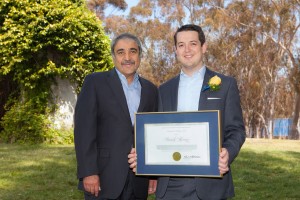 Congratulations to this year’s recipients of the UC San Diego Academic Senate Distinguished Teaching Award. The prestigious award is bestowed upon faculty and graduate students to honor teaching excellence. Recipients are selected for their creativity, innovative teaching methods, ability to motivate students and commitment to teaching. At the annual awards ceremony today at the Faculty Club, Chancellor Khosla congratulated each awardee and commented that it is because of our amazing achievers – like our honorees – that UC San Diego has become a world-renowned public research university in only five decades.
Congratulations to this year’s recipients of the UC San Diego Academic Senate Distinguished Teaching Award. The prestigious award is bestowed upon faculty and graduate students to honor teaching excellence. Recipients are selected for their creativity, innovative teaching methods, ability to motivate students and commitment to teaching. At the annual awards ceremony today at the Faculty Club, Chancellor Khosla congratulated each awardee and commented that it is because of our amazing achievers – like our honorees – that UC San Diego has become a world-renowned public research university in only five decades.
Prof. Mercier’s award nomination read:
“Patrick Mercier is an exceptionally talented engineering teacher, mentor, researcher, and colleague. The following characteristics have been used to describe Professor Mercier and what makes him an outstanding teacher: abundance of enthusiasm to excite and motivate the next generation of learners; a deep understanding of fundamental concepts and their relation to practical applications; the ability to explain both fundamental and advanced concepts in various engaging ways; and a passionate commitment to help students learn. One student wrote, “Professor Mercier, as far as my own experiences have provided me, is the epitome of what an exemplary and passionate teacher can be. Through his highly effective teaching methods, his compassion and genuine care for his students, and his infectious passion for the teacher profession, Professor Mercier defines the concept of teaching excellence for me in every sense.”
Prof. Mercier is the first faculty member in Electrical and Computer Engineering to win this award since Jack Wolf won the award in 1999.
A Mouthguard that Monitors your Health – Inside Science TV
The next time you visit the doctor for a checkup, they may not need a vial of your blood. A sample of your spit might be all your doctor needs. Check out the following video from Inside Science TV from the American Institute of Physics.
https://youtu.be/HtKLCbvRg5E?list=PLPe4mEu2EKttKkwVnVkJOstwnaOUBCLTO
VLSI paper and 3 ISCAS papers
 Congrats to Jiwoong Park, Hui Wang, and collaborative students from Prof. Cauwenberghs Lab, who will presenting the latest results in fully-on-chip regulating rectification at the VLSI Symposium in Honolulu, Hawaii in June 2016.
Congrats to Jiwoong Park, Hui Wang, and collaborative students from Prof. Cauwenberghs Lab, who will presenting the latest results in fully-on-chip regulating rectification at the VLSI Symposium in Honolulu, Hawaii in June 2016.
Also, congrats to Hui Wang, Julian Warchall, Aishwarya Balakrishnan, Somayeh Imani, and collaborators, who will be presenting papers on picowatt-level current references, low-power rugged EEG acquisition techniques, and wearable chemical sensors at the International Symposium on Circuits and Systems in Montreal, Canada, in May 2016. 
Prof. Mercier wins DARPA Young Faculty Award
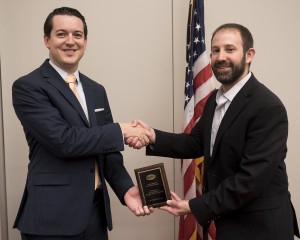
Photo by: Sun L. Vega
The Microsystems Technology Office (MTO) hosted the Young Faculty Award Program (YFA) at DARPA in Arlington, Virginia. The objective of the DARPA FYA Program, is to identify and engage, rising research stars in junior faculty positions at academic and non-profit research institutions, and expose them to the Department of Defense (DOD) needs and DARPA’s program development process. Congratulations to Prof. Mercier!
ISSCC Paper
 Congrats to Loai Salem and John Louie, who have a paper entitled “A Flying-Domain DC-DC Converter Powering a Cortex-M0 Processor with 90.8% Efficiency” accepted for publication at the 2016 edition of the International Solid-State Circuits Conference! More details about this completely new type of DC-DC converter will be available after the conference in February 2016.
Congrats to Loai Salem and John Louie, who have a paper entitled “A Flying-Domain DC-DC Converter Powering a Cortex-M0 Processor with 90.8% Efficiency” accepted for publication at the 2016 edition of the International Solid-State Circuits Conference! More details about this completely new type of DC-DC converter will be available after the conference in February 2016.
